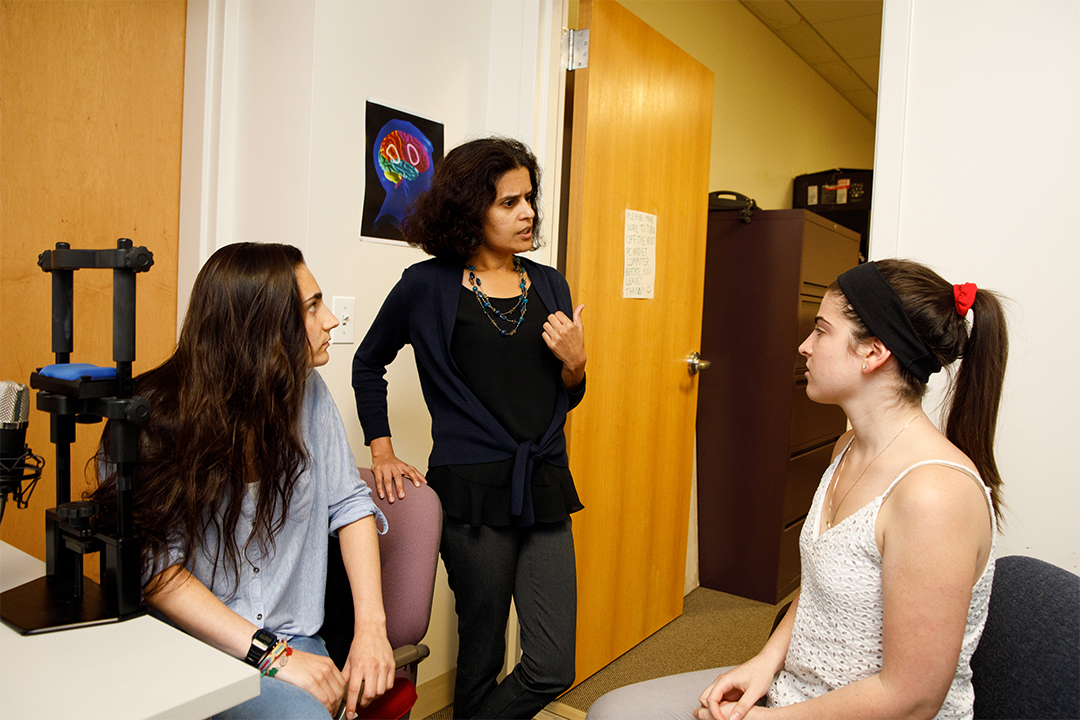For the more than one million Americans suffering from aphasia, their own brains can feel like prison cells. The severity of the neurological disorder varies widely, but it almost always involves an inability to communicate. People’s thoughts and perceptions are usually clear in their minds. But they cannot express them through speech.
Aphasia can make people feel like they are trapped inside their own heads, explained Malathi Thothathiri, associate professor of speech, language and hearing science. “You might see, for example, a pencil. You can understand what it is and what it does. But if I hold up a pencil and ask you to name it, you struggle to produce the word.”
The disorder, which is mainly due to brain tissue damage from strokes and head trauma, can be so mild that it’s not immediately noticeable. A person with aphasia may at first seem to have simply forgotten what they wanted to say. Or, in the most severe instances, they can lose almost all language function, like speaking or understanding speech. Some can no longer read or write.
But while aphasia is more common than Parkinson’s Disease, cerebral palsy or muscular dystrophy, there are still more questions than answers on how the brain is affected and the best treatment options. In a major new research study, Thothathiri is tackling another gray area: whether aphasia is solely a language disorder or if there is a broader underlying cause that affects language as well as other abilities.
As collaborators in a five-year, $1.6 million National Institutes of Health-funded project, Thothathiri and her team of graduate and undergraduate student researchers will look for a link between general decision-making abilities and aphasia-related language impairments. “There’s a long history in neuroscience of thinking that language is separate from the other things we do—like controlling our behavior or moving our bodies,” she said. “We are challenging that idea more and more.”
That debate is front and center in aphasia research. In the past, aphasia has been categorized as a language disorder alone. That definition, Thothathiri noted, implies that the disorder only impacts language functions—not decision making as well.
Language in itself, she said, involves a series of unconscious decisions. “When you’re talking, your brain is making a lot of decisions, such as which particular words to use, which particular sentence structures to follow,” she said. “And when you’re listening, your brain is constantly deciding what exactly sentences mean. There’s a lot going on under the hood.” Aphasia damage, she said, may impair a person’s ability to make those decisions and connections.
Although some people with aphasia improve over years and even decades, a complete recovery is unlikely after the first few months. It’s generally treated through extensive rehabilitation exercises with a speech pathologist. Recently, some researchers have adopted brain stimulation with electrically-charged batteries. By relating general decision making to decision-making-in-language, Thothathiri’s study can broaden treatment options for people with aphasia.
In a multi-site, collaborative project involving as many as 100 patients, Thothathiri’s team will employ cutting-edge cognitive neuroscience and experimental psychology techniques. They will map brain activity with EEGs and functional MRIs. And they will employ eye-tracking technology to collect moment-to-moment information on how their subjects interpret language. “Our eyes move in accordance with what our brain is thinking,” Thothathiri explained.
Graduate student Maria Braiuca demonstrates eye-tracking technology that charts which image patients are viewing in response to verbal cues.
First-year graduate student Maria Braiuca designed an exercise to follow eye movement as people are asked to choose pictures that correspond to sample sentences. “One picture matches the sentence exactly and the other picture is the exact reversal,” she said. “We can see where they are looking on the screen” as the brain weighs a decision. As part of the project, Kasey Lerner, a senior majoring in speech, language, and hearing sciences, is putting together tests of patients’ broader abilities, including short-term memory and decision making.
For both students, the study will provide their first clinical opportunity to work directly with people with aphasia. “I think one of the most important components of working with them is the establishment of a strong patient-clinician rapport,” Lerner said. Indeed, Thothathiri emphasizes that her students must show empathy and patience with their subjects, and she reminds them that aphasia is not a mental impairment. “Just because they cannot tell you what their thoughts are, don’t assume they don’t have clear and concise thoughts,” she said. “They just can’t put them into words.”



